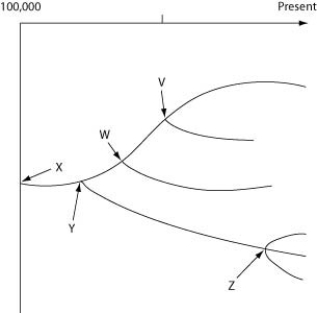A) Species diversity declines further from the equator.
B) Fewer species live on islands than on the nearest continents.
C) Birds live on islands located further from the mainland than the birds' maximum nonstop flight distance.
D) Australian temperate plants are more similar to Australian tropical plants than to the temperate plants of Europe.
Correct Answer

verified
Correct Answer
verified
Multiple Choice
Within six months of effectively using methicillin to treat S. aureus infections in a community, all new S.aureus infections were caused by MRSA. How can this best be explained?
A) A patient must have become infected with MRSA from another community.
B) In response to the drug, S. aureus began making drug-resistant versions of the protein targeted by the drug.
C) Some drug-resistant bacteria were present at the start of treatment, and natural selection increased their frequency.
D) S. aureus evolved to resist vaccines.
Correct Answer

verified
Correct Answer
verified
Multiple Choice
If the bacterium Staphylococcus aureus experiences a cost for maintaining one or more antibiotic-resistance genes, what would happen in environments that lack antibiotics?
A) These genes would be maintained in case the antibiotics appear.
B) These bacteria would be outcompeted and replaced by bacteria that have lost these genes.
C) These bacteria would try to make the cost worthwhile by locating and migrating to microenvironments where traces of antibiotics are present.
D) The number of genes conveying antibiotic resistance would increase in these bacteria.
Correct Answer

verified
Correct Answer
verified
Multiple Choice
Currently, two of the living elephant species (X and Y) are placed in the genus Loxodonta, and a third surviving species (Z) is placed in the genus Elephas. Assuming this classification reflects evolutionary relatedness, which of the following is the most accurate phylogenetic tree?
A) ![]()
B) ![]()
C) ![]()
D) ![]()
Correct Answer

verified
Correct Answer
verified
Multiple Choice
A farmer uses triazine herbicide to control pigweed in his field. For the first few years, the triazine works well and almost all the pigweed dies; but after several years, the farmer sees more and more pigweed. Which of these statements explains why the pigweed reappeared?
A) The herbicide company lost its triazine formula and started selling poor-quality triazine.
B) Natural selection caused the pigweed to mutate, creating a new triazine-resistant species.
C) Triazine-resistant pigweed has less-efficient photosynthesis metabolism.
D) Triazine-resistant weeds were more likely to survive and reproduce.
Correct Answer

verified
Correct Answer
verified
Multiple Choice
The horizontal axis of the cladogram depicted below is a timeline that extends from 100,000 years ago to the present; the vertical axis represents nothing in particular. The labelled branch points on the tree (V-Z) represent various common ancestors. Let's say that only since 50,000 years ago has there been enough variation between the lineages depicted here to separate them into distinct species, and only the tips of the lineages on this tree represent distinct species.  In Darwin's tree of life, each fork in the tree represents ________.
In Darwin's tree of life, each fork in the tree represents ________.
A) groups of living organisms
B) groups of extinct organisms
C) the most recent common ancestor of the subsequent branches
D) morphologic gaps in the fossil record
Correct Answer

verified
Correct Answer
verified
Multiple Choice
Which one of the following observations did Darwin first make during his discovery of evolution?
A) The ability of individuals to survive and reproduce is not equal.
B) There is variation in inherited traits.
C) Individuals who reproduce more leave more offspring.
D) The unequal ability to reproduce leads to the accumulation of favourable traits in a population.
Correct Answer

verified
Correct Answer
verified
Multiple Choice
What must be true of any organ described as vestigial?
A) It must be analogous to some feature in an ancestor.
B) It must be homologous to some feature in an ancestor.
C) It must be both homologous and analogous to some feature in an ancestor.
D) It need be neither homologous nor analogous to some feature in an ancestor.
Correct Answer

verified
Correct Answer
verified
Multiple Choice
Given what we know about evolutionary biology, we expect to find the largest number of endemic species in which of the following geological features, which have existed for at least a few million years?
A) an isolated ocean island in the tropics
B) an extensive mountain range
C) a grassland in the centre of a large continent, with extreme climatic conditions
D) a shallow estuary on a warm-water coast
Correct Answer

verified
Correct Answer
verified
Multiple Choice
About 13 different species of finches inhabit the Galápagos Islands today, all descendants of a common ancestor from the South American mainland that arrived a few million years ago. Genetically, there are four distinct lineages, but the thirteen species are currently classified among three genera. The first lineage to diverge from the ancestral lineage was the warbler finch (genus Certhidea) . Next to diverge was the vegetarian finch (genus Camarhynchus) , followed by five tree finch species (also in genus Camarhynchus) and six ground finch species (genus Geospiza) . If the six ground finch species have evolved most recently, then which of these is the most logical prediction?
A) They should be limited to the six islands that most recently emerged from the sea.
B) Their genomes should be more similar to each other than are the genomes of the five tree finch species.
C) They should share fewer anatomical homologies with each other than they share with the tree finches.
D) The chances of hybridisation between two ground finch species should be less than the chances of hybridisation between two tree finch species.
Correct Answer

verified
Correct Answer
verified
Multiple Choice
What are adaptations?
A) geologic changes over time
B) rocks containing fossils
C) inherited characteristics of organisms that enhance their survival
D) descent with modification from a common ancestor
Correct Answer

verified
Correct Answer
verified
Multiple Choice
 If x indicates the location of fossils of two closely related species, then fossils of their most-recent common ancestor are most likely to occur in which stratum?
If x indicates the location of fossils of two closely related species, then fossils of their most-recent common ancestor are most likely to occur in which stratum?
A) A
B) B
C) C
D) D
Correct Answer

verified
Correct Answer
verified
Multiple Choice
Which of the following factors could cause a surge in population size?
A) a decrease in available food
B) an increase in the number of predators
C) better eyesight evolves in the population
D) decreased camouflage evolves in the population
Correct Answer

verified
Correct Answer
verified
Multiple Choice
Which statement illustrates the connection between natural selection and overreproduction of a population?
A) Populations vary in their inherited traits.
B) Species produce more offspring than can survive in the environment.
C) Individuals with inherited traits that promote survival tend to have more surviving offspring.
D) Individuals with traits that do not enhance survival cannot reproduce.
Correct Answer

verified
Correct Answer
verified
Multiple Choice
Darwin used the phrase "descent with modification" to explain ________.
A) unity of life
B) descent of all organisms from a single, ancient ancestor
C) that habitat differences stimulate change in organisms
D) evolution of the unity and diversity of life
Correct Answer

verified
Correct Answer
verified
Multiple Choice
The upper forelimbs of humans and bats have fairly similar skeletal structures, whereas the corresponding bones in whales have very different shapes and proportions. However, genetic data suggest that all three kinds of organisms diverged from a common ancestor at about the same time. Which of the following is the most likely explanation for these data?
A) Forelimb evolution was adaptive in people and bats, but not in whales.
B) Natural selection in an aquatic environment resulted in significant changes to whale forelimb anatomy.
C) Genes mutate faster in whales than in humans or bats.
D) Whales are not properly classified as mammals.
Correct Answer

verified
Correct Answer
verified
Multiple Choice
Fossils found in strata reveal that ________.
A) older strata carry fossils that differ greatly from living organisms
B) geologic changes occur quickly on Earth
C) unused body parts decrease in size
D) innate drive to complexity of life
Correct Answer

verified
Correct Answer
verified
Multiple Choice
Pseudogenes are ________.
A) composed of RNA, rather than DNA
B) the same things as introns
C) unrelated genes that code for the same gene product
D) nonfunctional vestigial genes
Correct Answer

verified
Correct Answer
verified
Multiple Choice
Which of the following statements describe evolution?
A) Individuals evolve in response to their environment.
B) The match between organism and their environment decreases.
C) Natural selection chooses the most popular trait.
D) Quick changes occur in an individual's phenotype.
Correct Answer

verified
Correct Answer
verified
Multiple Choice
Darwin and Wallace's theory of evolution by natural selection was revolutionary because it ________.
A) was the first theory to refute the ideas of special creation
B) proved that individuals acclimated to their environment over time
C) dismissed the idea that species are constant and emphasised the importance of variation and change in populations
D) was the first time a biologist had proposed that species changed through time
Correct Answer

verified
Correct Answer
verified
Showing 21 - 40 of 60
Related Exams